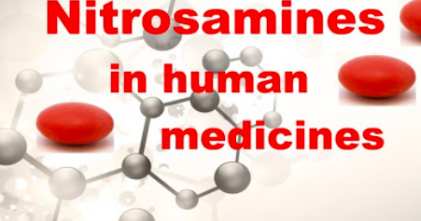The European medicines regulatory network has issued recommendations on impurities in medicines following the conclusion of an exercise to draw on lessons learnt from the presence of nitrosamines in a class of blood pressure medicines known as sartans.
Nitrosamines are chemical compounds classified as probable human carcinogens on the basis of animal studies. However, there is a very low risk that nitrosamine impurities at the levels found could cause cancer in humans.
EMEA Article 31 review of sartans identified a number of root causes of nitrosamine formation and contamination, below are few examples:
- Nitrosamine impurities can form during API processing under certain processing conditions and in the presence of some types of raw materials, starting materials, and intermediates. They may not be fully purged in subsequent steps of the API manufacturing process.
- The use of sodium nitrite (NaNO2), or other nitrites, in the presence of secondary or tertiary amines is a potential cause of nitrosamine formation.
- Nitrosamines may also be present in APIs following the use of contaminated raw materials in the manufacturing process. Recycled solvents, reagents and catalysts, may pose a risk for nitrosamine formation due to the presence of amines in the waste streams sent for recovery and the subsequent quenching of these materials with nitrous acid to destroy residual azide, without adequate control of nitrosamine formation or adequate purification.
- It is also known that the recovery of materials (e.g. solvents, reagents and catalysts) is often outsourced to third parties. In some cases, the third party recovery facilities do not receive enough specific information on the content of the materials they are processing and rely on routine recovery processes carried out in non-dedicated equipment. This can potentially lead to cross- contamination of solvents, reagents and catalysts from various sources or processes if equipment is not adequately cleaned between customers, or if precautions to avoid nitrosamine formation are not in place.
- Another source of nitrosamines may be contaminated starting materials, including intermediates supplied by vendors that use processing methods or raw materials causing formation of nitrosamines. For example, nitrites are known impurities in raw materials, including reagents, solvents, and excipients used in finished products.
The new EMA recommendations aim to clarify the roles and responsibilities of companies involved in the manufacture of medicines and to amend guidance on controlling impurities and good manufacturing practice. The recommendations also cover the management of impurities once detected, communication with patients and healthcare professionals, and international cooperation.
The recommendations include:
- developing additional guidance on:
- the roles and responsibilities of companies involved in the manufacture of medicines;
- controlling impurities;
- good manufacturing practice (GMP);
- sampling and testing.
- improving communication with patients and healthcare professionals;
- expanding cooperation with international partners;
- further developing information technology systems.
The full recommendations are available on EMA’s website. https://www.ema.europa.eu/en/documents/report/lessons-learnt-presence-n-nitrosamine-impurities-sartan-medicines_en.pdf
These recommendations apply to all medicines.
Reference:

Leave a Reply